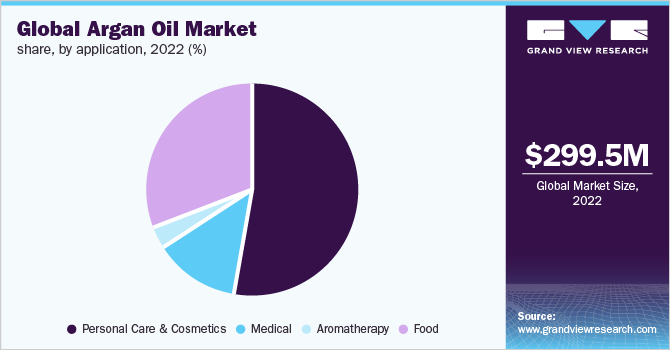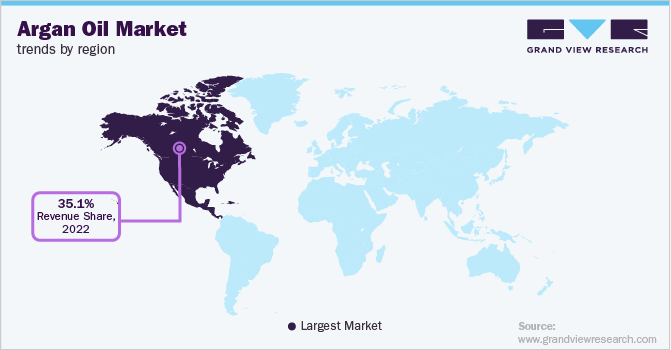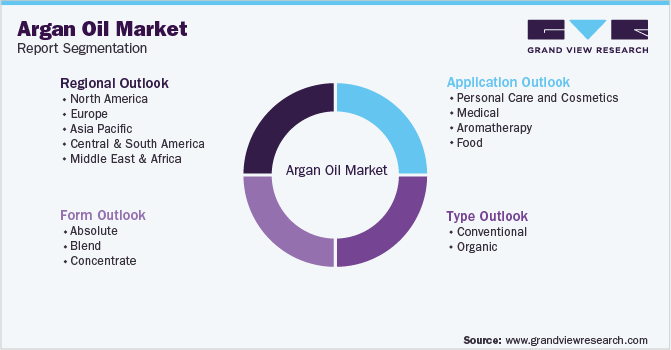- Home
- »
- Renewable Chemicals
- »
-
Global Argan Oil Market Size & Trends Analysis Report, 2030GVR Report cover
![Argan Oil Market Size, Share & Trends Report]()
Argan Oil Market (2023 - 2030) Size, Share & Trends Analysis Report By Type (Conventional, Organic), By Form (Absolute, Blend), By Application (Medical, Food), By Region (North America, APAC), And Segment Forecasts
- Report ID: 978-1-68038-671-4
- Number of Report Pages: 80
- Format: PDF
- Historical Range: 2018 - 2021
- Forecast Period: 2023 - 2030
- Industry: Specialty & Chemicals
- Report Summary
- Table of Contents
- Interactive Charts
- Methodology
- Download FREE Sample
-
Download Sample Report
Argan Oil Market Summary
The global argan oil market size was estimated at USD 299.45 million in 2022 and is projected to reach USD 712.5 million by 2030, growing at a CAGR of 11.4% from 2023 to 2030. Rising demand from the culinary, medical, and personal care & cosmetics industries is expected to fuel the market growth.
Key Market Trends & Insights
- North America dominated the industry in 2022 and accounted for the largest share of 35.1% of the overall revenue.
- On the basis of types, the conventional type segment dominated the industry in 2022 and accounted for the largest share of 59.5% of the overall revenue.
- On the basis of forms, absolute form segment dominated the global industryin 2022 and accounted for thelargest share of more than 57.50% of the overall revenue.
- On the basis of applications, the personal care application segment dominated the industry in 2022 and accounted for the largest share of 52.9% of the overall revenue.
Market Size & Forecast
- 2022 Market Size: USD 299.45 Million
- 2030 Projected Market Size: USD 712.5 Million
- CAGR (2023-2030): 10.7%
- North America: Largest market in 2022
The personal care & cosmetics sector is expanding due to consumers' growing awareness about the importance of improving both their overall appearance and way of life. The prevalence of skin and hair problems, such as acne, dermatitis, dry & damaged hair, and skin aging issues, is on the rise across the world, and has prompted people to switch from synthetic to natural personal care products.According to the Loreal Annual Report, 2020, estimated market of cosmetics is estimated to be more than 200 billion euros.The organic skincare market in the countries like the U.K., France, and Germany is on the rise as major manufacturers like L'Oréal and Lakme are coming up with different argan oil-infused products, such as hair serums and gel creams.Over the past few years, there has been an increase in the usage of men's grooming products like hair oils, shower gels, beard oils, skin creams, and waxes that contain argan oil and other essential oils, which, in turn, are helping the product market to grow.Argan oil production and harvesting require a lot of labor and resources.

The Berber women who gather and forage the fruit from the argan trees perform the labor-intensive work. The task is carried out by hand. The high price of oil as a result of all these variables will make it difficult for the market to expand. Due to the product’s high cost, some sellers dilute argan oil by adding other oils to it before selling it. The U.S. is the largest market in North America and accounts for a significant chunk of global sales.The fast-expanding cosmetics culture of the U.S. offers a variety of favorable conditions for the expansion of the domestic argan oil business.The American Society of Plastic Surgeons (ASPS) estimates that Americans spent over $16.5 billion on aesthetic plastic surgery in 2018, an increase of about 4% from the year before.
In addition, with a value of USD 5.4 billion, the nation was the second-largest importer of cosmetics after China in 2018. Due to its outstanding antibacterial, healing, and natural cleansing characteristics, argan oil is frequently used in the U.S. as a treatment for many skin conditions, such as acne, eczema, and dermatitis. Technological innovation and favorable regulatory conditions in the U.S. are likely to contribute to the market’s overall growth. According to the Food and Drug Administration (FDA), the product can be used to restore hair growth, treat varicose, reduce cellulite, and for cell regeneration.
Type Insights
On the basis of types, the global industry has been further categorized into conventional and organic. The conventional type segment dominated the industry in 2022 and accounted for the largest share of 59.5% of the overall revenue. The high share of this segment can be attributed to the rising interest in cosmetics containing argan. Traditional argan oil is made from the argan tree's kernels and is a valuable source of essential fatty acids and other elements.In general, conventional argan oil is processed into edible and beauty grades.
Virgin or edible argan oil is a copper-colored liquid, has a slight hazelnut taste, and is prepared from slightly roasted kernels. It contains 43 to 49% oleic and 29 to 36% linoleic acid. On the other hand, beauty-grade argan oil is a golden color liquid prepared from unroasted kernels and has no taste. Aromatherapy often uses organic argan oil. When harvesting organic argan, bio-based fertilizers including compost manure, bone meal, and green manure are used to boost crop productivity. As a luxury product, argan oil is becoming increasingly popular among international cosmetics corporations.
Form Insights
On the basis of forms, the global industry has been further categorized into absolute, blend, and concentrate. The absolute form segment dominated the global industryin 2022 and accounted for thelargest share of more than 57.50% of the overall revenue. The growth in this segment can be attributed to the increasing demand for absolute forms of the product in cosmetics, aromatherapy, and medical applications. It is a highly concentrated version produced from plant kernels using solvent extraction procedures.
The kernels are pulverized before being suspended in solvents to produce this form. The solvents are evaporated after a series of such operations to obtain the product.Argan concentrate is the oil in its purest form. It is a labor- and time-intensive process to make product concentrates. In addition, this form has a high concentration of flavonoids and antioxidants, which make it appropriate only for skincare applications. The blend form segment is also estimated to witness steady growth over the forecast period.
Application Insights
On the basis of applications, the global industry has been further categorized into personal care & cosmetics, medical, aromatherapy, and food. The personal care application segment dominated the industry in 2022 and accounted for the largest share of 52.9% of the overall revenue. This is attributed to product usage in hair care as well as skincare products, such as hair oils, shampoos, conditioners, hair serums, moisturizers, environmental defense products, anti-aging creams, and lip balms among others.

Factors, such as the increasing participation of women in the workforce and the growing aging population, are triggering the demand for argan oil in cosmetics. Manufacturers are expanding their product lines with enhanced product solutions to meet consumer needs. There is an ascending demand for environmental defense skincare products that protect the skin from microorganisms as well as harmful UV radiation. As the skin is recurrently exposed to the sun and increasing pollution, it is prone to become dry and dull due to UV radiation and dust. Environmental defense skincare products help protect as well as enhance skin health,which increasesthe demand for argan oil-infused skin care products.
Regional Insights
North America dominated the industry in 2022 and accounted for the largest share of 35.1% of the overall revenue. This was attributed to the growing use of bio-based cosmetics, personal care products, and aromatherapy goods. It is used in aromatherapy healing to promote the health of the body, spirit, and mind.Aromatherapy massage balances the body, reduces stress, and helps various body functions battle illnesses. As a result, aromatherapy goods have become popular in North America and are widely available in specialty stores and online shopping malls. Hair care products are expected to be in high demand as a result of increased innovation in hair styling techniques and consumer awareness regarding attractive looks, particularly in developed economies, such as North America.

Skincare products are anticipated to have high market penetration owing to the growing number of consumers, especially women, who are increasingly becoming conscious of their appearance. Growing incidences of skin disorders worldwide have probed consumers to shift from synthetic to natural personal care products. The growth of the organic skincare sector in the U.K., France, and Germany coupled with product innovations by key manufacturers, such as L’Oréal, is expected to increase product demand in the near future. The U.S. is the biggest argan oil consumer as more people are becoming aware of the product's advantages for their health, skin, and hair.
The biggest consumers of the product in the U.S. are the personal care and cosmetics sectors. The demand for various personal care and cosmetic products is anticipated to rise in the U.S., as a result of the expanding population and the remarkable health benefits of argan oil.This is anticipated to have a beneficial positiveimpact on the expansion of the product market in the country.The product contains polyunsaturated fatty acids and active compounds, such as antioxidants, xanthophyll, sterols, and carotenoids, which are significantly useful in the pharmaceutical industry.
According to the European Federation of Pharmaceutical Industries and Associations (EFPIA), the pharmaceutical market in the European Union accounted for over USD 200 million in 2018, positioning it as the second-biggest pharmaceutical market in the world, with Germany, France, Italy, the U.K., and Spain as the top 5 countries.The personal care and cosmetics sectors dominate the market in Europe. Shampoos, moisturizers, and anti-wrinkle cosmetic products are the main uses of the product, which is primarily processed in Europe by solvent extraction of kernels.
Key Companies & Market Share Insights
The global industry is highly competitive and fragmented with the presence of a large number of players. Several argan oil-based skin care products have been introduced by companies, such as Lakme, OLVEA, St. Botanica, and others, over the years. The productdemand has also been steadily increasing, in key hair care industry participants including L'Oréal and Unilever thus all these factors are expected to increase their product consumption owing to the growing demand from consumers.Industry participants are trying to expand their operations in untapped regions to gain higher market share and increase their competitive advantage.
They are coming up with new trends and innovations to gain the confidence of consumers. In Jan 2021, Olvea Group declared that “COSMOS Natural” certification has been granted to all of its specialized vegetable oils, including argan oil for cosmetic usage. The COSMOS standard ensures that these vegetable oils are 100% physically processed agro-ingredients and that they are produced using environmentally friendly methods (PPAI). Thus, their authenticity and naturalness are best kept. Some of the prominent players in the global argan oil market include:
-
OLVEA
-
ARGANisme
-
Pure Argan Co.
-
DSM
-
Malakbio
-
Lipidine
-
Argane Aouzac
-
Organica Group Ltd.
-
Arganfarm sarl. au.
-
Zidrop Argan Oil
-
ARGANBULK
Argan Oil Market Report Scope
Report Attribute
Details
Market size value in 2023
USD 331.3 million
Revenue forecast in 2030
USD 712.5 million
Growth rate
CAGR of 11.4% from 2023 to 2030
Base year for estimation
2022
Historical data
2018 - 2021
Forecast period
2023 - 2030
Quantitative units
Revenue in USD million, volume in tons, and CAGR from 2023 to 2030
Report coverage
Revenue forecast, volume forecast, company ranking, competitive landscape, growth factors, and trends
Segments covered
Type, form, application,region
Regional scope
North America; Central & South America; Europe; Asia Pacific; Middle East & Africa
Country scope
U.S.; Canada; Mexico; U.K.; Germany; France; China; India; Japan; Brazil; Morocco; GCC
Key companies profiled
OLVEA; ARGANisme; Pure Argan Co.; DSM; Malakbio; Lipidine; Argane Aouzac; Organica Group Ltd.; Arganfarm sarl. Au.; Zidrop Argan Oil; ARGANBULK
Customization scope
Free report customization (equivalent up to 8 analysts working days) with purchase. Addition or alteration to country, regional & segment scope.
Pricing and purchase options
Avail customized purchase options to meet your exact research needs. Explore purchase options
Global Argan Oil Market Segmentation
This report forecasts revenue growth at global, regional, and country levels and provides an analysis of the latest industry trends in each of the sub-segments from 2018 to 2030. For the purpose of this study, Grand View Research has segmented the global argan oil market report on the basis of type, form, application, and region:

-
Type Outlook (Volume, Tons; Revenue, USD Million, 2018 - 2030)
-
Conventional
-
Organic
-
-
Form Outlook (Volume, Tons; Revenue, USD Million, 2018 - 2030)
-
Absolute
-
Blend
-
Concentrate
-
-
Application Outlook (Volume, Tons; Revenue, USD Million, 2018 - 2030)
-
Personal Care and Cosmetics
-
Medical
-
Aromatherapy
-
Food
-
-
Regional Outlook (Volume, Tons; Revenue, USD Million, 2018 - 2030)
-
North America
-
U.S.
-
Canada
-
Mexico
-
-
Europe
-
U.K.
-
Germany
-
France
-
-
Asia Pacific
-
China
-
India
-
Japan
-
-
Central and South America
-
Brazil
-
-
Middle East & Africa
-
Morocco
-
GCC
-
-
Frequently Asked Questions About This Report
b. The global argan oil market size was estimated at USD 299.45 million in 2022 and is expected to reach USD 331.3 million in 2023.
b. The global argan oil market is expected to grow at a compound annual growth rate of 11.3% from 2023 to 2030 to reach USD 712.5 million by 2030.
b. North America dominated the market in 2021 with a revenue share of 34.7% this is attributed to the growing use of bio-based cosmetics, personal care products, and aromatherapy goods.
b. Some key players operating in the argan oil market include OLVEA, ARGANisme, Zineglob, PURUS (Purus International), Malakbio, Argane Aouzac, Organica Group LTD, Arganfarm, Kamakhya Bottlers, Zidrop Argan Oil, and ARGANBULK
b. Key factors that are driving the market growth include increasing awareness regarding ingredients such as omega 3 and omega 6 fatty acids, lupeol, beta amyrin, antioxidant tocopherols, triterpenoids, and butyrospermol in the argan oil.
Share this report with your colleague or friend.
Need a Tailored Report?
Customize this report to your needs — add regions, segments, or data points, with 20% free customization.

ISO 9001:2015 & 27001:2022 Certified
We are GDPR and CCPA compliant! Your transaction & personal information is safe and secure. For more details, please read our privacy policy.
Trusted market insights - try a free sample
See how our reports are structured and why industry leaders rely on Grand View Research. Get a free sample or ask us to tailor this report to your needs.










